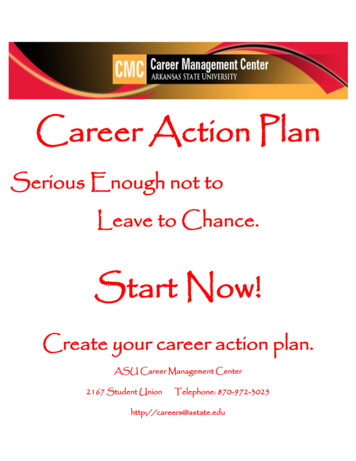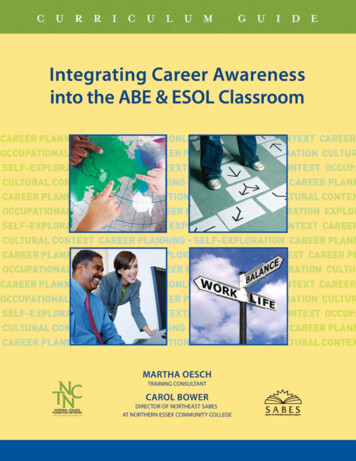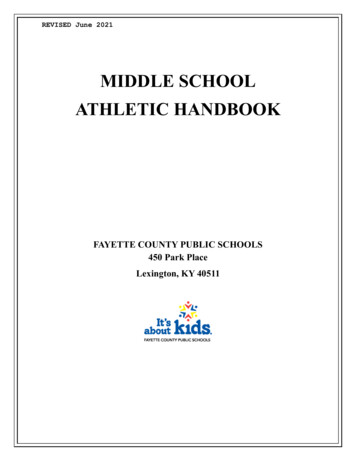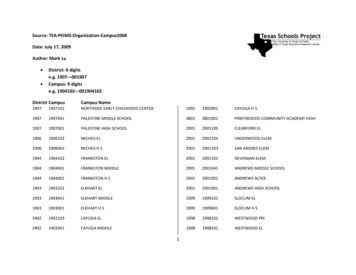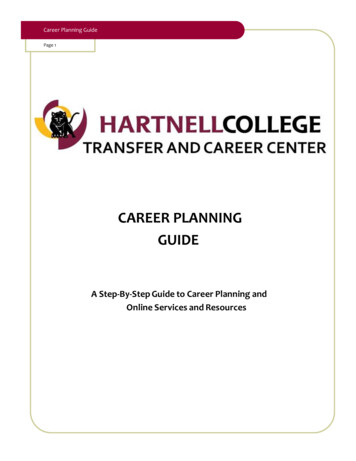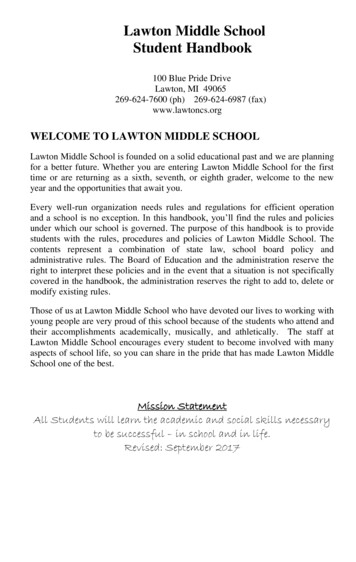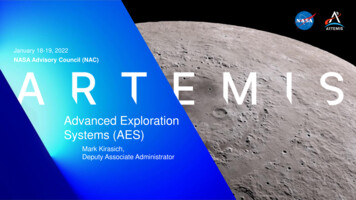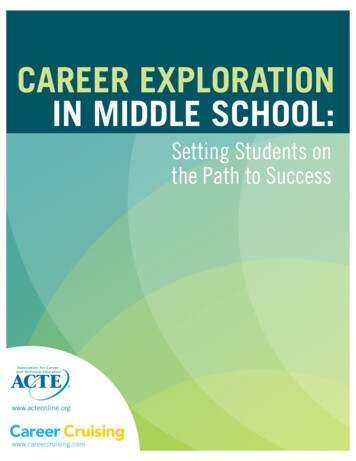
Transcription
CAREER EXPLORATIONIN MIDDLE SCHOOL:Setting Students onthe Path to Successwww.acteonline.orgwww.careercruising.com
CAREER EXPLORATION IN MIDDLE SCHOOL:Setting Students on the Path to SuccessExecutive SummaryResearch has identified middle school as a time when studentscan benefit the most from career exploration, a process ofbuilding self-awareness, learning about potential careers, anddeveloping a plan for reaching future goals. Career explorationengages middle school students at a time when they are ata higher risk for disengaging from learning due to challengesin forming identity, coping with puberty and navigating newenvironments. It also capitalizes on their developing abilities tothink abstractly, and their preferences for teamwork and activelearning through relevant real-life scenarios. These preferencesmake middle school a natural time for students to learn aboutcareers and develop skills such as problem solving, criticalthinking and teamwork through career exploration activities.While career exploration has proven benefits for middle-gradesstudents, programs and activities can be difficult to implementdue to a lack of funding, a focus on core academic coursesand overburdened school counselors. Educators, administrators and counselors have developed a variety of flexiblepractices to overcome these barriers.Research has identified middle schoolas a time when students can benefitthe most from career exploration.Middle-grades students have further opportunities to explorefuture options through career and technical student organizations (CTSOs) and work-based learning activities. An intracurricular element of many CTE programs, CTSOs help studentsdevelop leadership skills and connect with business leadersthrough service activities and industry-based competitions.Students can also interact with employers though workplacetours, job shadowing and other work-based learning activities.To help teachers, counselors and administrators implementand improve these practices at the program, school anddistrict levels, ACTE recommends the following:1. Incorporate career-related project-based learningin the classroom.A key way career exploration is provided to middle schoolstudents is through exploratory and introductory CTE courses. These courses help students identify careers of interestand develop employability skills that will serve them in further education and the workplace. They can be delivered invarious ways, from yearlong classes that address all 16 CareerClusters to semester-length courses in one broad career area,with the common goal to provide opportunities for studentsto learn about career and education pathways and to buildemployability skills.2. D esign projects and activities to develop employability skills.Middle school students can also craft personalized educationand career plans, in collaboration with parents, counselorsand teachers, to help guide decisions about future course-taking and potential careers. Scalable technology like CareerCruising can support and enhance this planning while keepingstudents’ options open.While these recommendations focus on strategies at the locallevel, states play a major role in ensuring access to careerexploration in the middle grades, as evidenced by recent statelegislation. Policymakers at all levels should work to ensuretheir states recognize the critical importance of middle-gradescareer exploration and embrace supportive policies.A key way career exploration is providedto middle school students is throughexploratory and introductory CTE courses.13. Be flexible when offering exploratory and introductoryCTE courses.4. Facilitate academic and career planning with scalableonline tools.5. Enable short-term interactions with business andcommunity leaders.6. Provide opportunities for CTSO participation, includingfinancial support when needed.
CAREER EXPLORATION IN MIDDLE SCHOOL:Setting Students on the Path to SuccessMiddle school is a time of transition in a young person’s life.Students’ experiences in the middle grades have a stronginfluence on whether they will close achievement gaps, complete high school and be considered college-ready, particularlystudents in high-poverty neighborhoods.1At the transition to middle school, students are at a higherrisk for disengaging from learning as they face challenges informing identity, coping with puberty and navigating new environments.2 Middle school students may also have unrealisticcareer plans, and know little about the demands of the workplace or how their education choices relate to future careers.3Girls, minorities and at-risk students are more likely to begin tolimit their career aspirations after being exposed to stereotypesabout which jobs are appropriate for whom.4To help them stay engaged and plan for their futures, middleschoolers need educational experiences that match their stageof intellectual and social-emotional development. Individualslearn to think more abstractly in early adolescence—to testhypotheses, synthesize information and solve problems.5They prefer to learn through teamwork and authentic, real-lifescenarios.6 Middle-grades students want to explore topicsthey find interesting and relevant, including careers, and theywant to do so in active, hands-on ways.7 During these years,adolescents also develop a greater capacity to think about andplan for the future.8 These factors make middle school a natural time for students to explore careers and gain employabilityskills that will serve them well in the future.Career Exploration andEmployability Skills in Middle SchoolCareer exploration is a process of learning about oneself andthe world of work, identifying potential careers, and developing a strategy for realizing education and career goals.9 TheNational Career Development Association recommends thatmiddle school students learn about themselves by developing awareness of their occupational interests, aptitudesand career values; gaining an understanding of the valueand concept of work; and making preliminary occupationalchoices that are open to change.10 Self-knowledge is a necessary first step toward developing decision-making skills foreducation and careers, even as goals and interests changeover time.Research has identified middle school as a time when students can benefit the most from career exploration.11 Inaddition, middle schoolers’ brains are receptive to developingthe competencies known as 21st-century skills, non-cognitiveskills, soft skills or employability skills. These skills includecritical thinking, adaptability, problem solving, oral and writtencommunications, collaboration, creativity, responsibility, professionalism, ethics and technology use.12 Employers reportthat employability skills are critical to the workforce, and manyare also positively associated with academic achievement andpostsecondary success.13Career and technical education (CTE) is well positioned tohelp students explore careers and develop employability skillsin middle school and beyond. According to research: CTE students are significantly more likely than their peers tosay that they developed a clear career goal as well as problem-solving, critical-thinking, communication, time management and work-related skills, according to a study thatcompared CTE and non-CTE students as they transitionedinto postsecondary education.142
CAREER EXPLORATION IN MIDDLE SCHOOL:Setting Students on the Path to Success T he more that students participate in career and technicalstudent organizations (CTSOs)—an integral intracurricularcomponent of many CTE programs that features competitive events, business and community partnerships, andleadership experiences—the higher their academic motivation and engagement, grades, employability skills, careerself-efficacy and college aspirations.15 Work-based learning has been found to help students gainan understanding of the work environment, increase motivation, support work readiness, enhance job-related skillsand knowledge, improve school attendance and reducedropout rates.16 Students who participate in career guidance, career courses and computer-based guidance systems demonstrategreater knowledge of jobs, higher self-esteem and bettergrades, and are engaged more in career and academicplanning.17 “Making” (or “makerspaces”) is a related concept toCTE that prioritizes hands-on learning to build creativity,open-mindedness, persistence, social responsibility andteamwork.18CTE is also a key strategy identified by the National DropoutPrevention Center/Network at Clemson University. Researchshows that CTE and career guidance help keep students inschool and positively impact student persistence.19 In fact, 81percent of students who left high school without a diplomareported that relevant, real-world learning opportunities wouldhave kept them in school—a particularly relevant numbergiven the research that suggests many students begin disengaging in middle school.20Barriers to Middle School Career ExplorationCareer exploration has proven benefits for middle-gradesstudents, but educators, counselors and administrators facechallenges in providing exploration activities.CTE is also a key strategy identifiedby the National Dropout PreventionCenter/Network at Clemson University.3Historically, the education system has struggled with how toeducate early adolescents moving from childhood to youngadulthood. In the latter half of the last century, the U.S. education system transitioned from junior high schools teaching acurriculum that mirrored a high school curriculum, to middleschools, which focused on an interdisciplinary curriculum,exploration and supportive relationships.21 There were almost12,000 middle schools in the nation at the beginning of the21st century.22However, the philosophy of middle school as a developmentalspace for early adolescents has increasingly conflicted withpressure to improve test scores. Some middle schools haveresponded by reducing time for electives and guidance activities, including career exploration.23 And while CTE is gainingpopularity, some parents and educators still think that buildingstudents’ career skills relegates them to a separate track forthe non-college-bound.24A lack of school counselors also impairs career exploration inmiddle school and across the education pipeline. Counselorsand other guidance and career development professionals assist students with self-exploration and future planning, and areinstrumental in supporting career exploration in the classroomand through extended learning experiences like work-basedlearning and CTSOs. Yet the national average for the ratio ofcounselors to students is 1:491, almost double that recommended by the American School Counselor Association.25Middle schools also have financial challenges, receiving just 8percent of the federal funding that postsecondary educationreceived in Fiscal Year 2015.26 Federal funds apportionedto states through the Carl D. Perkins Career and TechnicalEducation Act support career exploration in middle school;however, Perkins funding for states has been maintained ator near 1.1 billion for several years, about 150 million lessthan Fiscal Year 2010 levels. Perkins funding is also morelikely to be distributed to high school CTE programs.
CAREER EXPLORATION IN MIDDLE SCHOOL:Setting Students on the Path to SuccessThese funding struggles translate to barriers for career exploration, including costs associated with technology and otherresources.27 Extended learning experiences can also be hampered by a lack of funds, as well as policies that discourageoff-site activities due to safety and liability concerns.To overcome these barriers, educators and administratorshave developed a variety of flexible practices for middle schoolcareer exploration, including exploratory and introductoryCTE courses, career and academic planning through scalabletechnology, CTSOs and work-based learning experiences.Exploratory and Introductory CTE CoursesCTE courses in middle school help students explore within the16 Career Clusters of the National Career Clusters Framework , which encompasses more than 79 education andcareer pathways.28 This learning engages students in identifying careers of interest and developing employability skills forfurther education and the workplace.Students in Indiana take the Exploring College and Careerscourse in middle school, investigating their interests, strengthsand goals in relationship to the Career Clusters and Indiana’sCollege and Career Pathways. Activities typically include completing interest inventories, meeting in-person and virtuallywith business and military representatives, creating resumesand cover letters, discussing postsecondary options andsetting goals. Students may also create and compare budgetsbased on the average income they can expect to earn withdifferent levels of education.30Fairfax County in Virginia offers middle school courses in threebroad career areas: business and IT, family and consumersciences (FACS) and technology and engineering. In technology and engineering courses, students explore careers inthese fields while beginning to learn the design process andhow to solve problems with technology. Students work individually and in groups on activities such as building bridges andracing dragsters.31Middle school CTE courses can be delivered in a variety ofways to meet student needs while taking into account schoolresources and capacity. Some middle schools may offer acourse that explores all 16 Career Clusters, while others mayprovide courses that introduce students to one, two or threebroad career areas. Introductory courses may also lead directly into specific CTE programs of study in nearby high schools.In addition, career development lessons can be split up andintegrated across the curriculum.Project-based learning, a fundamental CTE instructionalstrategy, is often used in middle school career exploration.Students develop their knowledge and skills by working ona project, problem or question with real-world relevance. InWest County Middle School in Missouri, eighth-graders spendthe year investigating a career that interests them and preparing related materials like resumes.32 The Career Town programculminates in an event where students present their career ofchoice in front of parents and representatives from local jobcenters and colleges.Minimal data is available on how many students participate inthese types of courses; however, a Cornell University Centerfor Advanced Human Resource Studies report estimates that,on average, a middle school student at the beginning of the21st century participated in around one year of introductoryCTE coursework.29Employability skills are often incorporated into these coursesas well. At Morrison High School, a rural school for gradesseven to twelve in Oklahoma, students can explore FACS,business and agriculture. These courses emphasize careerawareness, motivating students to develop strong work habitsto help them transition to more in-depth CTE programs in4
CAREER EXPLORATION IN MIDDLE SCHOOL:Setting Students on the Path to Successhigher grades. Interpersonal, communication and socialskills are key, and students are evaluated on their work ethic,behavior and accountability. Alumni report that this approachhas contributed to their success in the workplace.33While exploratory and introductory CTE courses can bestructured in different ways, they should all incorporateacademic and technical content with real-world relevance,supported by project-based learning, technology, and opportunities to learn about various careers and education pathways.34 These courses should also be integrated with strongcareer guidance systems.Career and Academic PlanningStudents often begin crafting personalized education andcareer plans in middle school to help guide decisions aboutfuture course-taking and career exploration. The plans areknown by many names, including individualized graduationand learning plans, and are typically developed in collaboration with counselors, educators and parents. Career development technology can enhance this planning, offering tools thatcan be flexibly configured and scaled to meet local, state andregional needs.According to research from the National Collaborative onWorkforce and Disability for Youth, individualized learningplans are a promising strategy for all students when they areimplemented starting in middle school; incorporate a webbased career information system with an e-portfolio; andinclude opportunities for self and career exploration, workbased learning and the development of employability skills.36The National Association of Secondary School Principals alsorecommends that middle school students start developingindividualized graduation plans in middle school.37Starting in the 2017-2018 school year, students in Wisconsinmust have access to the state’s academic and career planning5Tennessee has developed a middle school STEM sequenceof three courses that foster technical, academic and employability skills through career exploration. The introductorycourse, STEM Explorers, teaches sixth-grade students howworkers in STEM fields define and solve problems to benefitsociety. Students also research a wide variety of CareerClusters and participate in activities like creating modelsof manufacturing processes or collecting, graphing andanalyzing health care data. STEM Explorers emphasizesthe importance of problem-solving skills and gives studentspractice in reading, interpreting and applying workplacesafety rules.In the next course in the sequence, STEM Innovators,seventh-graders research how famous innovators haveused STEM to advance industry and society, as well as howtechnology has advanced within specific Career Clusters.They examine innovation processes and propose improvements to existing products such as wind turbines. Studentsfinish the course with projects like creating 3D printingmodels or developing proposals to host “makerspace”events.The final middle school course, STEM Designers, reinforces the problem-solving skills that the STEM Explorerscourse introduced, with a greater focus on using computational thinking and evidence-based arguments. Eighthgrade students evaluate and improve existing engineeringdesign processes, and address engineering challengesrelated to specific objects—bridges, for example—bydeveloping sketches and models.The latter two courses in the middle school STEM sequence maintain the focus on employability skills whiledelving deeper into STEM content. Austin Christian, aneighth-grader at Christiana Middle School, says the STEMprogram teaches life skills, while teacher Dawn Powellshares how students have been inspired by seeing aproject, such as building and launching a rocket, throughto its outcome.35
CAREER EXPLORATION IN MIDDLE SCHOOL:Setting Students on the Path to SuccessStudents in Virginia are required by a 2009 regulation todevelop an Academic and Career Plan beginning in theseventh grade.40 Seventh-graders select a Career Clusterthat will guide their high school course selection and makepreliminary plans regarding postsecondary education andcredentials, including industry certifications. This planningis based on interest inventories, self-exploration activitiesand conversations with parents, counselors and teachers.Through the planning process, the Virginia Department ofEducation (VDOE) hopes to promote students’ understanding of how their education choices impact their long-termcareer choices, as well as how behaviors such as punctuality, courtesy, language and hard work are essential tosuccess in the job market. Students are also encouragedto demonstrate initiative, teamwork, problem-solving,organization and communication competencies.The VDOE provides resources to teachers, counselors andadministrators on how middle schools can incorporateacademic and career planning into daily instruction. TheDepartment has partnered with the Southern Regional Education Board to provide middle and high school staff withprofessional development workshops through the Counseling for Careers program. Counseling for Careers strategieshelp educators and counselors better personalize students’Academic and Career Plan learning experiences to makedeveloping these plans more meaningful.41 According toJason Suhr of Roanoke County Public Schools, Virginia’sacademic and career planning “encourages a high level ofstudent involvement, which is key to encouraging buy-in forthe student.”42(ACP) services by grade six.38 ACP is a collaborative processthat helps students make choices that align with high schoolgraduation requirements, personal interests and career goals.It also incorporates an online portfolio that documents the student’s plan and relevant activities. ACP is a holistic approachto education and career development, with implementationoptions at the local level.In Wisconsin’s DeForest Area School District, students startparticipating in ACP as early as the fifth grade, reflecting ontheir skills, hobbies, interests and role models. This early planning builds upon engagement with business representativesduring elementary school through the Adopt-a-Class program.Students continue to explore throughout middle school, andin eighth grade, they meet with counselors and parents tochoose a preferred Career Cluster and discuss high schooland postsecondary options.39Career Cruising, an online exploration and planning programthat supports future readiness, is Wisconsin’s preferredthird-party technology provider to support ACP. Students learnabout themselves and potential careers through interest, skillsand learning styles inventories; an ability profiler; in-depthinformation on education, careers and job outlook; and anonline portfolio.Flexibility is key to education and career planning in middleand high school, and learning plans should be revisited regularly in light of new experiences. Online tools can help guidedecision-making about future options while keeping studentsopen to multiple pathways.Extended Learning: CTSOs andWork-based LearningMiddle school students have further opportunities to explorecareers and develop employability skills through CTSOs andwork-based learning experiences.6
CAREER EXPLORATION IN MIDDLE SCHOOL:Setting Students on the Path to SuccessAn intracurricular element of many CTE programs, CTSOssupport and expand on what students learn in their CTEcourses through community service and industry-based competitive events at the local, state and national levels. CTSOshelp students build their skills in creativity, problem solvingand teamwork and set goals based on an understanding oftheir career values, interests and strengths. More than 2 million middle, high school and postsecondary students participate nationwide in 11 CTSOs that each map to one or moreCareer Clusters.43Students in CTSOs cultivate their knowledge about the workplace by interacting with local employers, who act as mentors and judges for competitions, and with CTSO teacher-advisers. CTSOs also offer activities to build the confidence andleadership skills of middle-grades students specifically. Forinstance, in Future Business Leaders of America’s (FBLA’s)Middle Level division, the Middle Level Achievement Program rewards junior high and middle school members whenthey complete activities in the areas of service, educationand leadership.In addition to working with industry representatives throughCTSO activities, middle school students can connect withemployers both in and out of the classroom though introductory work-based learning experiences like workplace tours,guest speakers and job shadowing.44 These typically shortterm interactions build a base of knowledge and experiencefor more intensive secondary and postsecondary work-basedlearning experiences.For instance, mentorship from business leaders is core tothe curriculum developed by the Network for Teaching Entrepreneurship (NFTE) and implemented in middle schoolsacross the nation. Through NFTE courses, students explorea range of careers based on their interests and learn aboutentrepreneurship, both as a career option and as a way to7The Inspire Sheboygan County program has been connecting Wisconsin middle school students, employers and thecommunity to mutual benefit since 2013, powered by Inspireby Career Cruising. Through this cloud-based platform, companies can share information about themselves and theirwork-based learning opportunities; students can learn fromvolunteer career coaches using discussion boards and messaging tools; and employers and students can connect forinterviews, job shadowing, workplace tours and internships.Inspire Sheboygan County now has 71 participating businesses, almost 400 volunteer career coaches and morethan 10,000 active student portfolios, spanning middleschool, high school and postsecondary education.47 Thisgrowth is supported by a committee that shares metricsand resources for member businesses, who pay an annualfee based on size.Through Inspire Sheboygan County more students areasking professionals for career advice and participating inwork-based learning, according to school administrators.Frequently, career fairs and guest speakers lead to jobshadowing experiences. With students exploring careeroptions and employers identifying their future workforce,it is a win-win situation. According to Colleen Vollbrechtof Rockline Industries, “[Inspire Sheboygan County] drivescollaboration between school systems and businesses toensure we are meeting the needs of the students in ourcommunity and the future needs of our businesses.”48
CAREER EXPLORATION IN MIDDLE SCHOOL:Setting Students on the Path to Successsolve problems for people and communities. Volunteers fromlocal or national corporate partners speak in classrooms;host site visits; and work as coaches, mentors and judgesfor NFTE’s Business Expo, at which students present theirbusiness concepts.45Job shadowing is another option for middle school careerexploration, in which students spend the day with an adulton the job, observing and participating in daily activities.This short-term activity brings students together with business leaders to cultivate interest in occupations and increaseknowledge of the work inherent in these jobs. Since passageof the Education and Economic Development Act in SouthCarolina in 2005, a landmark piece of state legislation addressing CTE and career guidance, employers in that statehave hosted more than 125,000 students per year duringCTE Month and Groundhog Job Shadow Days, supported byresources that emphasize preparation, effective communication, workplace safety and behavior, and reflection after thefact.46 And, when job shadowing is more difficult to access—for instance, in rural areas or for careers that raise safety andliability concerns—students can take advantage of virtual jobshadowing experiences.Recommendations for PractitionersCareer exploration in middle school is crucial for engagingstudents and helping them prepare for the future, and thereare multiple strategies for delivering career exploration thatmeet student needs while considering challenges such aslack of funding, overburdened staff and tightly-packed schoolschedules. The following recommendations are aimed atteachers, counselors and administrators looking to implementand improve the practices described in this paper at theprogram, school and district levels, as well as state and localpolicymakers seeking to strengthen policies around middleschool career exploration.1. I ncorporate career-related project-based learningin the classroom.Project-based learning is a fundamental CTE instructionalapproach that can engage middle-grades students in learning about careers. To make projects relevant for middleschoolers, teachers should start with a topic that is personally meaningful to students and grounded in their choices,such as developing a product or process used in a careerthat interests them.49 High-quality projects also generatequestions for students to investigate, incorporate feedbackand revision, result in presentations that build oral communication skills and pave the way for further exploration.502. D esign projects and activities to developemployability skills.Projects and other activities should foster employabilityskills, as students assess the skills and knowledge neededfor a project, collaborate with others and solve any issuesthat occur. Students also learn proper workplace behaviorwhen classrooms and laboratories mimic the rules and culture of the related work environment. In addition, studentscan learn to be conscious about career decision-making—another skill with lifelong value—when counselors andeducators help them think critically about their interests,abilities and goals.3. B e flexible when offering exploratory andintroductory CTE courses.There are a variety of models for offering middle-gradesstudents exploratory and introductory CTE courses, fromyearlong courses that address all 16 Career Clusters tosemester-length courses in one broad career area. Teacher content expertise will impact these decisions, as wellas scheduling and whether the school is affiliated with anarea career center that provides CTE programs to students in several schools and districts. Virtual learning cansupplement a middle school’s ability to offer exploration inmultiple career areas.Project-based learning is a fundamentalCTE instructional approach that canengage middle-grades students in learningabout careers.8
CAREER EXPLORATION IN MIDDLE SCHOOL:Setting Students on the Path to Success4. Facilitate academic and career planningwith scalable online tools.Online planning and exploration programs supportmiddle school career exploration with a trove of up-todate information on education, careers and employmentand wage projections. These programs also incorporateonline inventories and assessments to help studentslearn about their skills, strengths
Middle school is a time of transition in a young person's life. Students' experiences in the middle grades have a strong influence on whether they will close achievement gaps, com-plete high school and be considered college-ready, particularly students in high-poverty neighborhoods.1 At the transition to middle school, students are at a higher
